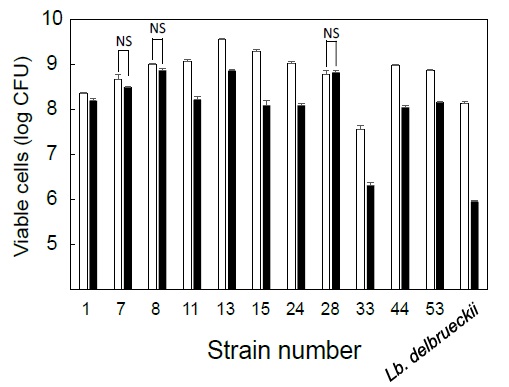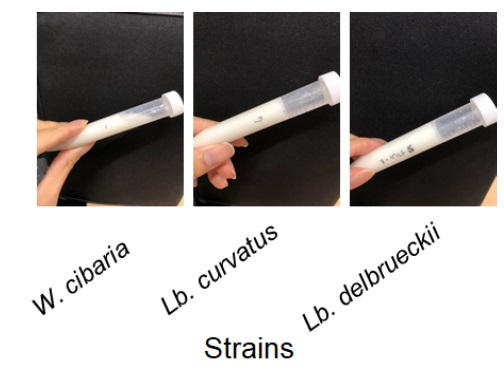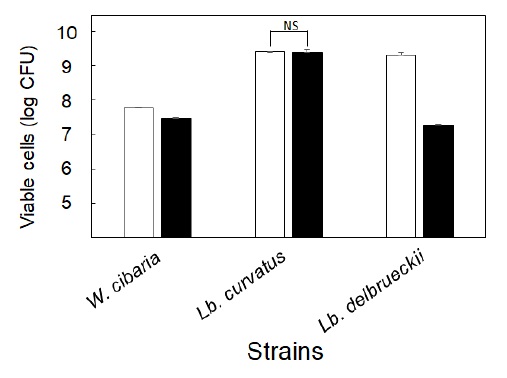Journal Name: Journal of Applied Microbiological Research
Article Type: Research
Received date: 17 April, 2020
Accepted date: 01 May, 2020
Published date: 08 May, 2020
Citation: Ikai R, Tanabe K, Shima J (2020) Lactobacillus curvatus Strains Specifically Show High Levels of Tolerance to Freeze-Thaw Stress. J Appl Microb Res. Vol: 3 Issu: 1 (27-30).
Copyright: © 2020 Shima J . This is an open-access article distributed under the terms of the Creative Commons Attribution License, which permits unrestricted use, distribution, and reproduction in any medium, provided the original author and source are credited.
Abstract
Introduction: Tolerance to freeze-thaw stress is an important characteristic in recent fermentation processes.
Methodology: To gain insight into the freeze-thaw tolerance of lactic acid bacteria (LAB), screening experiments were performed.
Results: The screening experiments suggested that 4 strains of LAB showed high freeze-tolerance even in the absence of cryoprotectants. Homology alignments analysis for the LAB strains was performed using partial sequencing of 16S rDNA. The results revealed that 3 strains belong to Lactobacillus curvatus and one strain belongs to Weissella cibaria. These Lb. curvatus strains also showed high levels of freeze tolerance in a milk fermentation process. These data indicate that Lb. curvatus has specific mechanisms underlying its tolerance to freeze-thaw stress.
Conclusion: This study demonstrate that Lb. curvatus strains frequently show high levels of freeze-thaw tolerance in both culture and milk and that Lb. curvatus strains are suitable as a model species for investigations of the molecular mechanisms underlying freeze-thaw tolerance in LAB and for applications in fermentation industries.
KeyWords
Lactic acid bacteria; Freeze-thaw stress; Stress tolerance.
Abstract
Introduction: Tolerance to freeze-thaw stress is an important characteristic in recent fermentation processes.
Methodology: To gain insight into the freeze-thaw tolerance of lactic acid bacteria (LAB), screening experiments were performed.
Results: The screening experiments suggested that 4 strains of LAB showed high freeze-tolerance even in the absence of cryoprotectants. Homology alignments analysis for the LAB strains was performed using partial sequencing of 16S rDNA. The results revealed that 3 strains belong to Lactobacillus curvatus and one strain belongs to Weissella cibaria. These Lb. curvatus strains also showed high levels of freeze tolerance in a milk fermentation process. These data indicate that Lb. curvatus has specific mechanisms underlying its tolerance to freeze-thaw stress.
Conclusion: This study demonstrate that Lb. curvatus strains frequently show high levels of freeze-thaw tolerance in both culture and milk and that Lb. curvatus strains are suitable as a model species for investigations of the molecular mechanisms underlying freeze-thaw tolerance in LAB and for applications in fermentation industries.
KeyWords
Lactic acid bacteria; Freeze-thaw stress; Stress tolerance.
Background
The responses of various microorganisms to environmental stress have drawn attention in both fundamental [1] and fermentation sciences [2]. In fermentation science, tolerance to environmental stress is a useful characteristic of microorganisms used in fermentation such as lactic acid bacteria (LAB) and yeast [2,3], because such tolerance can improve fermentation processes. Freeze-thaw stress has become important to the more recently developed fermentation processes, as part of the efforts to improve the processes of the production and preservation of fermented foods including LAB [4,5]. Freeze-thaw stress is a complex stress that can consist of dehydration, physical stressors, low temperature, and/or oxidative stresses [2].
In fermentation industries using LAB, starter cultures were mainly prepared by freeze- drying [6]. However, the freeze-drying is considered as expensive and complex process. Insights on stress tolerant mechanisms to freeze-stress in LAB may contribute to improve the starter preparation for maximization of survival cells.
To the best of our knowledge, mechanisms underlying the tolerance of LAB to freeze-thaw stress have not been reported. It is known that cryoprotectants (e.g., glycerol and glutamate) improve the survivability of LAB after freeze-thaw stress [7,8]. To gain insight into the freeze-thaw tolerance of lactic acid bacteria (LAB), screening experiments were performed for identificatiion of LAB strains which have high level of freezethaw tolerance under absence of cryoprotectants.
Methods
Strains
LAB strains (~70 strains), which were originally isolated from fermented foods and plants, used as the screening resource. These strains were preserved at -80°C at Microbial Sciences Laboratory in Ryukoku University.
Primary screening
LAB strains were cultivated for 48 h at 30°C in 5 ml of MRS broth (BD Biosciences, San Jose, CA) under anaerobic conditions provided by an AnaeroPack (Sugiyama-gen Co., Tokyo). The cultures (5 mL) were frozen for 4 d at −25°C and thawed at 30°C, and they were then subjected to the same −25°C freeze for 4 d followed by thawing at 30°C. It was necessary to perform freeze-thaw treatments twice because significant differences among the tested strains were not detected when a single freeze-thaw treatment was administered. Portions (100 μ) of the samples were inoculated into 5 mL of fresh MRS broth and cultivated for 48 h at 30°C under anaerobic conditions. The optical density at 600 nm (OD600) was measured using a spectrophotometer (Bio Spectrometer, Eppendorf Hamburg, Germany).
Secondary screening
The LAB strains that were selected by the primary screening were used for secondary screening. The strains cultivated for 48 h at 30°C in 5 ml of MRS broth. The cultures were frozen for 4 d at −25°C and then thawed at 30°C. The samples’ CFU after the freezing and thawing treatment was determined by plating the samples with appropriate dilution with saline (0.9% NaCl) onto MRS agar medium at 30°C in triplicate. After 48 h incubations, the numbers of viable colonies were counted. As control experiments, the CFU were also measured in the samples before the freezing.
Taxonomic identification: We performed a taxonomic identification of the screened strains based on a partial sequence of 16S rDNA by the method described by Kawamoto et al. [9]. We determined the homology of the sequences by conducting a BLAST search of the DNA Data Bank of Japan (DDBJ). Homology alignments analysis with type strains were performed using ApE software. The sequences of the LAB strains obtained in this study were deposited in the DDBJ.
Survivability in fermented milk during frozenthaw treatment: The LAB strains were cultivated for 48 h at 30oC in 5 ml of MRS broth. The cells were collected by centrifugation (3,000 g for 10 min), washed with saline, and then added into 10 mL of milk containing 3.6% of total fat (Meiji, Tokyo) and incubated for 24 h at 30°C. The fermented milk (10 mL) was frozen for 3 d at −25°C. The survivability of the cells in milk or solidified milk was estimated by the pour plate method. In brief, portions (100 μ) of the fermented milk were mixed with MRS agar (20 mL) medium and then poured into petri dishes in triplicate. After 48 h incubations, viable colonies were counted.
Results
Primary screening for freeze-thaw tolerant LAB strains
As a primary screening, the growth ability of the 70 LAB strains after repeated freeze-thaw treatments was assessed. Lactobacillus delbrueckii subsp. bulgaricus isolated from a commercial yogurt product was used as a control strain, and it showed approx. 0.1 of OD600 in these experimental conditions. Almost strains tested here showed lower OD600 compared with the control strain. Among all strains tested, 11 strains showed an OD600 >0.3; these 11 strains were used for the secondary screening.
Secondary screening for freeze-thaw tolerant LAB strains
In the secondary screening, the colony forming unit (CFU) was estimated after a freeze-thaw treatment of the 11 stains selected in the primary screening as described in Methods (Figure 1).
Figure 1: Survivability of LAB strains in culture. A: CFUs before and after freeze-thaw treatment. White bars and black bars present the CFUs before and after repeated freeze-thaw treatments, respectively. The data are average ± SD. NS indicates no significance (p > 0.05). Statistical differences were determined by t-test.
The CFU of each strain before and after the freeze-thaw treatment (Figure 1) revealed that before the freeze-thaw treatment, the CFUs of the strains ranged from 5 × 106 to 5 × 108. The CFU value of the control strain Lb. delbrueckii subsp. bulgaricus after the freeze-thaw treatment was greatly reduced to 1% of that before freezing. The CFU of three strains (IR7, IR8, and IR28) did not significantly reduced before and after the freeze-thaw treatment (p>0.05). IR1, with apparently higher p-value than other strains, also selected for further analysis.
Taxonomic identification for the selected LAB strains
A taxonomic identification of the four strains based on a partial sequence of 16S rDNA was performed. The homology of the sequences was determined by conducting a BLAST search of the DNA Data Bank of Japan (DDBJ). Homology alignments analysis with type strains were performed using ApE software (Table 1). The sequences of the LAB strains obtained in this study were deposited in the DDBJ. The accession numbers for the 16S rDNA sequences are as follows. W. cibaria IR1: LC520099. Lb. curvatus IR7: LC520100. Lb. curvatus IR8: LC520101. Lb. curvatus IR28: LC520102. Partial sequencing of 16S rDNA and the results of a homology alignments analysis suggested that IR7, IR8, and IR28 are strains belonging to the species Lb. curvatus and that IR1 belongs to the species Weissella cibaria (Table 1).
Table 1: Summary of the homology alignments analysis of the screened LAB strains.
| Strain | Homology (accession no. of reference sequence) |
|---|---|
| IR1 | 100% with Weissella cibaria LMG 17699T(NR_036924) |
| IR7 | 100 % with Lactobacillus curvatus JCM 1096T (LC063167) |
| IR8 | 100 % with Lactobacillus curvatus JCM 1096T (LC063167) |
| IR28 | 100 % with Lactobacillus curvatus JCM 1096T (LC063167) |
Survivability in fermented milk during frozen-thaw treatment
The survivability of the Lb. curvatus IR7 and W. cibaria IR1 strains in milk that contained a potential cryoprotectant, such as sugars and fats, was analyzed, because LAB strains are often used to produce fermented foods derived from milk products such as yogurt (Figure 2). After the addition of cells of Lb. curvatus to milk, strong coagulation of the milk was observed (Figure 2). In contrast, partial milk coagulation observed when W. cibaria IR1 was used under the same conditions.
Figure 2: Milk coagulation activity of the screened strains and a control strain.
The survivability of the cells in milk or solidified milk after freeze treatment for 3 d at −25°C was estimated as cells/mL. As shown in Figure 3, Lb. curvatus IR8 showed much higher survivability compared to W. cibaria IR1 and Lb. delbrueckii subsp. bulgaricus. These data suggested that Lb. curvatus strains may be useful in the production of fermented foods derived from milk.
Figure 3: Survivability of LAB strains in milk. A: CFUs before and after freeze-thaw treatment. White bars and black bars present the CFUs before and after freeze-thaw treatments, respectively. The data are average ± SD. NS indicates no significance (p > 0.05). Statistical differences were determined by t-test.
Discussion
Lb. curvatus, which are closely related to Lactobacillus sakei [10], is detected in a variety of resources including fermented foods and animal intestine, and Lb. curvatus has shown genomic diversity [11,12]. The present analyses identified three Lb. curvatus strains with freeze-thaw tolerance. The three strains were isolated from different resources. Although Lb. sakei was included in the screening resources, no Lb. sakei strain was detected as a freeze-thawtolerant strain in our previous experiments [data not shown].
Lb. curvatus strains screened in this study is well known to produce extracellular polysaccharide (EPS) [13], it is possible that EPS functions in cell protectants under freezing conditions [14]. Although the molecular mechanisms underlying tolerance to freeze-thaw stress are not fully understood, it is possible that Lb. curvatus has specific genes and/or cellular systems that contribute to the tolerance observed in three strains.
Conclusion
This study shows that Lb. curvatus strains show high levels of freeze-thaw tolerance under the absence of cryoprotectants. Lb. curvatus strains may be suitable as a model species for clarification of the molecular mechanisms underlying freeze-thaw tolerance in LAB and for applications in fermentation industries. The Lb. curvatus strains also showed high levels of freeze tolerance in a milk fermentation process, suggesting that Lb. curvatus strains may be useful in the production of fermented foods, such as frozen yogurt.
Conflict of Interest
The authors declare no conflicts of interest with respect to authorship and/or publication of this article.
Author’s Contribution
Conceived and designed the experiments: J Shima, Performed the experiments: R Ikai and K Tanabe,
Analysed the data: R Ikai and K Tanabe,
Contributed to the writing of the manuscript: J Shima,
Critically reviewed the manuscript: K Tanabe and R Ikai.
There are no references





